The post Guide To Layering Tile Trim And Profiles appeared first on The Tile Shop Blog.
]]>
Customizing Your Space
We’re sharing our best practices for layering tile to show you how you can take your space to the next level. The look below incorporates a combination of trim pieces and mosaics to transform a simple picture frame into an exquisite focal point.

Since this bathroom uses the Firenze Carrara marble collection throughout, the untrained eye may see it as quite simple. Look carefully at the transitions, and see if you can identify how many trim pieces are actually used to accomplish this sophisticated design.

Incorporating different shapes and sizes from the same tile collection can carry this elevated look through to other areas of the room, such as the backsplash, half wall

Thoughtful Transitioning
It’s important to think about how each part of your space will work together to form a unified environment. Utilizing trim pieces between different materials, sizes, shapes

Dimensional tile can create dramatic depth and texture, but it can also leave an uneven edge when paired with other selections (top left photo). Incorporating transitional trim pieces will offer a seamless solution from one style to the next. Similarly, they can be used on the floor to separate different areas within a space – the top right photo displays a subtle transition, while the photo below incorporates durable curb pieces for a more prominent separation from shower to floor.

For tiles that vary in size, double up somersets and run them vertically for the greatest impact.

Using transitions is also the perfect way to emphasize an accent tile in your design. In the photo below, layered trim pieces instantly elevate the Brushed Bronze with Glass Metal Mosaic backsplash, while coordinating beautifully with the surrounding ceramic subway tile.


Each trim piece has its own unique characteristics that make it perfect for specific uses.
Coordinating Finishes
Pictured below is an example of how trim and profile pieces can provide an opportunity to coordinate with fixtures. In cases where there’s no need for a transition or storage solution, metal profiles can be used in between tiles as a unique accent that can coordinate with other design elements, such as faucets or lighting.

Layering trim and profile pieces can make every tile design better by adding dimension and interest. It
When And Where To Layer Tile

4 Design Plans With Layered Tile
Need ideas for your next remodel? Here are a few examples of design plans that incorporate tile trim and profile pieces. Bring them into your local store or schedule a design consultation to discuss dimensions, quantity, styles and more.

Learn more about layering in our comprehensive guide to trim and accessories. Ready for the next step? Schedule a design consultation with a tile design expert today!

The post Guide To Layering Tile Trim And Profiles appeared first on The Tile Shop Blog.
]]>The post Our Favorite Tiled Bars appeared first on The Tile Shop Blog.
]]>This coffee-to-cocktail bar from the 2019 Fall One Room Challenge™ is a sight to behold! Nicole from Nicole White Designs opted for a bold, art deco tile and it paid off in a big, statement-making way.


This classic, simple bar can be dressed up or down for whatever purpose you want it to serve.

This welcoming rustic bar is the perfect place for a hot cup of coffee.

A crisp white backsplash is the perfect contrast to bold cabinetry.

A mirrored bar ups the glamour factor—perfect for entertaining and hosting!

A tiled bar is the perfect place to take a risk. Adding bold hues or patterns is one easy way to make your bar stand out. It’s meant to be a fun spot, right?

Shiplap walls, sea-green cabinets and a mosaic in a mix of soft neutrals combine to form a relaxed, beachy bar.

Want to achieve glamour without going too bold or dramatic? This gold mosaic adds just the perfect amount of glitter to make it special.

This Annie Selke tile featuring flecks of metallic gold create a soothing visual break from dark shelves and cabinets.

What to do with this in-between-rooms nook? Make it into a functional and beautiful bar, of course!

Reclaimed wood tiles are the perfect backdrop to this natural wood bar in a cozy basement.

On that note, we’re feeling a little thirsty. Don’t forget to share your Tile Shop tiled bar on our social media channels with #thetileshop. Ready to start your own project? Get started with a remote design consultation today!
The post Our Favorite Tiled Bars appeared first on The Tile Shop Blog.
]]>The post 2020 Tile Trend: 3D Sculptural appeared first on The Tile Shop Blog.
]]>Lots of 3D tiles incorporate geometric designs. By mixing and matching the different faces of the Tangram series, you can create an entirely unique patchwork look.

Sweeping movements make for a soft, serene landscape, perfect for relaxing in the bath after a long day.

Flora and fauna-inspired motifs bring a natural quality to 3D tiles. We love how this leaf design comes to dramatic life on a black accent wall.

A straight-stack pattern modernizes this matte sculptural tile.

A marble look brings a wink of tradition to this otherwise of-the-moment 3D subway tile.

Ready for a bold statement?! Just add color! Blue is a serene color that is well-loved in home design.

If you’re looking for a subtle way to add interest to your space, opt for a beautiful-yet-simple 3D tile, like the Charm Diamond.

The neutral hues of the Akros Elis Iris create a distinctive, one-of-a-kind shower while still creating that calming, at-home spa experience.

Get the look of an intricate mosaic with fewer grout lines when you utilize a large-format tile like this one.

Complete a bold sculptural look with coordinating trims, accents and finishing pieces. Learn how to layer your look with trim pieces and profiles here.

What do you get when you combine geometric, metallic and sculptural effects into one tile? A stunning statement wall that’s sure to wow.

Is there any tile more perfect for an eye-catching cocktail bar?

A natural stone mosaic blurs the lines between traditional and contemporary.

Ready to find a 3D tile that speaks to you? Schedule a design consultation today!
The post 2020 Tile Trend: 3D Sculptural appeared first on The Tile Shop Blog.
]]>The post 16 Tiled Laundry Rooms We Love appeared first on The Tile Shop Blog.
]]>Even with dark cabinets and floors, the natural light and a whimsical wallpaper brighten the mood in this room.

If you’re all about a light-and-airy color scheme, look no further! Charming wood accents bring a soft, earthy feel to the space.

Who wouldn’t want to look at a colorful, pretty floral pattern while sorting darks and lights? (If floral tile is more your style, check out our post on the topic!)

We’re sensing a floral theme. And it makes perfect sense. What better way to add a sense of openness and light than channeling the bounties of the outdoors?
A rainbow of colors, florals and bright, crips white—this laundry room checks all the boxes. Check out more transformations like this one from the spring 2019 One Room Challenge™ .

This more monochromatic color scheme still manages to brim with life and joy due to greenery and a lively mosaic. If you like how these trim pieces flatter the mosaic, learn more about layering on our blog post.

Bold patterns, ample storage and smart design. It’s fair to say we’re experiencing laundry room envy.

A different twist on laundry room design, this space uses rich earth tones and molded cabinetry to define a traditional space.

We love the mix of shapes and patterns in this space! A black-and-white color scheme balances the statement wallpaper effortlessly.

A transitional laundry room is perfect for incorporating contemporary touches with more traditional elements.

Patterned and encaustic tiles add modern farmhouse flair to room.

This space proves once again that black and white are always a classic color combo.

A softly patterned floor is the perfect complement to bold cabinets and fixtures.

Not a fan of wallpaper? Take the bold patterns onto the floor instead!

Rustic style meets modern amenities in this cozy farmhouse laundry room.

With vintage touches like these, we’re not sure we’re seeing a laundry room or an antique store.

Inspired to do some laundry? OK, that’s a stretch. Inspired to design a better laundry room? That’s better. Schedule your one-on-one design consultation today.
The post 16 Tiled Laundry Rooms We Love appeared first on The Tile Shop Blog.
]]>The post Guide to Tile Finishes appeared first on The Tile Shop Blog.
]]>Types of finishes
Finishes, or different effects on the surface of a tile that alter its appearance, are generally divided into ceramic, porcelain and other man-made tiles vs. stone categories because of the different ways the materials can be treated. First, we’ll explore the processes that define stone finishes and then look at man-made tiles.
Stone
Stone tile with a polished finish has been passed under a series of polishing wheels with increasingly finer pads using water and polishing compound to assist in the process. This results in a smooth and shiny tile, perfect for adding a touch of luxury and glamour to formal and traditional spaces. Marble is a one type of stone that is often polished.


Satin finishes are produced through the same process as polished but using fewer polishing wheels. This lends a softer and less shiny appearance to the tile, the perfect balance between polished and honed.

Honed tiles go through the same process as polished and satin but with even fewer wheels that result in a smooth matte finish. This is the most casual finish of the three, reflecting very little light and contemporizing a design.


For a brushed finish, stone is run under wheels with metal bristles to achieve an orange peel-like finish. Benefits of a brushed tile are that its texture provides softness, it handles wear and tear and has a relaxed character.
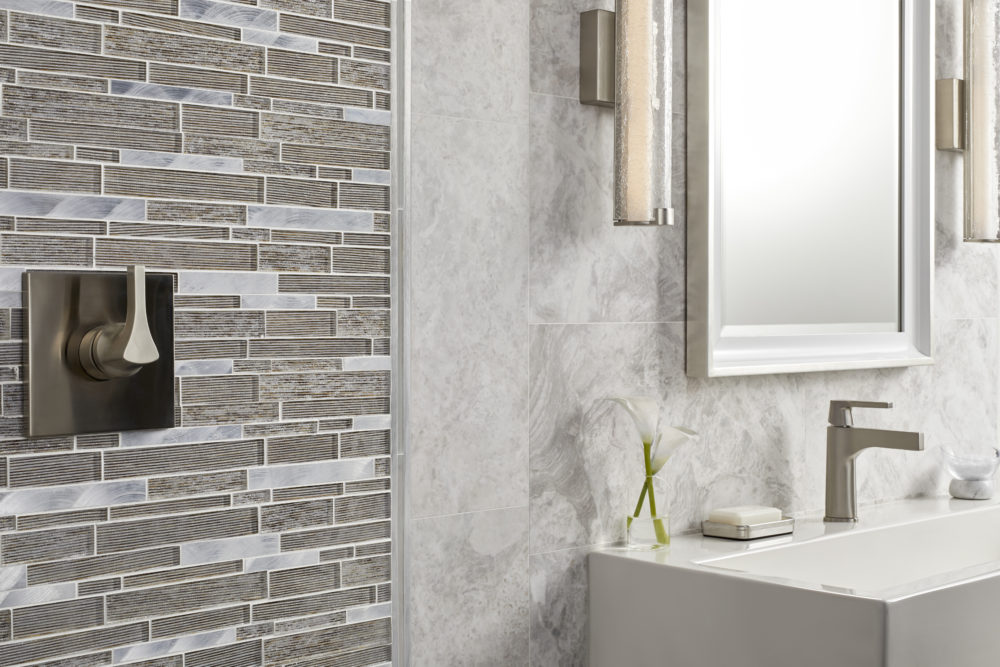
To obtain a tumbled finish, tiles are put into large drums filled with aggregate and shaken. The aggregate wears down the surface of the stone, giving it a rough surface and more rounded edges. Tumbled stones offer increased traction, hide imperfections and flawlessly coordinate with rustic décor.


We’re going au naturel with this one. With natural finish stone tile, what you see is what you get. Nothing is done to the surface of these tiles, and, besides being cut to size, they’re just like they looked when they were quarried. Natural tiles give an authentic and outdoorsy look to your space. Slate is a common example of a natural finish stone.


Filled and unfilled are not exactly finishes, but they alter the surface of a tile so they’re worth mentioning and defining here. Filled stone has its natural crevices and holes filled with an epoxy resin mixed with stone dust in a color that closely resembles the stone’s natural color. This makes the tile easier to clean and install. Unfilled stone is left in its natural state, voids and all. This allows you to choose to fill it with the grout color of your choice or leave it in its rustic, raw state for a unique look.
Here, you can see the difference in appearance of an unfilled travertine compared to a filled travertine. Bucak Silver Honed Unfilled Travertine, on the left, has visible holes and crevices on its surface, whereas Bucak Light Walnut Honed Filled Travertine, on the right, has a lighter colored compound filling in these areas.


Ceramic and Porcelain

Polished tiles are double fired, first with the desired pattern or color and then with a clear coat. Afterwards, they go through the same polishing process as stone, passing under polishing wheels with water and polishing compound. Lastly, the tiles are sealed to retain their appearance. Stone-look porcelain or ceramic tiles are often in polished finishes to mimic the look of natural stone.

A glossy finish is different from polished in that it is created with a glossy glaze instead of a polishing wheel process. Depending on the texture of the tile, gloss glazes can pool in areas, creating thicker and thinner areas of glaze and variations in coloring.

Matte tiles are covered in a non-shiny glaze that is applied with an ink jet machine or in a waterfall stream glazing method. This process yields tiles with a flat finish that do not reflect light and offer a contemporary look.

Multifired tiles are one of the most exciting technological advancements in the industry in recent years. They’re so interesting, we devoted a whole blog post to them! These are tiles that go through more than two firings in a kiln, usually to give them 3-D texture, metallic finish or another interesting effect that is not possible with just one or two firings.

An anti-slip surface is perfect for tiling in wet areas like bathrooms, entryways or mudrooms. They’re also great if aging in place is a consideration in your home. A fine grit or sand is added to a matte glaze to create a rough, gripping texture on the tile.

Textured tile is made by pressing materials into a mold that give a textured effect, such as that of natural stone or wood. Then it’s glazed and fired to achieve the desired look. The below tile is actually a porcelain that has been textured to look like a tumbled stone.

Congratulations! You’ve just completed a crash course in natural stone and man-made tile finishes. If your head is spinning, don’t worry. Our tile experts are waiting in your local store to help you design your next project and choose your perfect tile. Schedule a design consultation or stop in today.
The post Guide to Tile Finishes appeared first on The Tile Shop Blog.
]]>The post Maximalism: More is More appeared first on The Tile Shop Blog.
]]>White walls, minimal decor, subtle colors—you won’t find any of these in a maximalist space! Some people say that less is more, but maximalists believe the opposite. More color, more texture, and more boldness define this style. Simplistic, neutral design has reigned for years, and, inevitably, some people are ready for a change. Say hello to maximalism.
Contrary to what you might think, maximalism is more than just having a lot of stuff. Some of the hallmarks of maximalist design are:
- Patterns and prints
- Bold colors
- Ornateness
- Layering
- Lots of textures
- Artwork (especially different styles and mismatched frames!)
- Mixing design styles, like boho (it shares a common theme of excess), English, vintage, mid-century modern, Victorian and art deco
- Books, books and more books
The style is an updated twist on classically exuberant English interiors updated for the 21st century with bright colors, contemporary patterns and modern accents. The legendary club Annabel’s in London perfectly embodies this blend of classic Britishness and modern maximalism.
So, what do we love about maximalism? It allows you to express every side of your personality at once. If you’ve ever felt torn between styles or couldn’t define yours in one word, maximalism may be for you. (Indecisive friends, unite!) This design style allows you the freedom to fill your home with items that you love, instead of worrying about fitting them into a style box. Loving your decor is key—random items will not bring the same joy as a personalized, curated collection.
Enough talking about maximalism—let’s see some of our favorite looks! As far as maximalist designs go, this one is pretty minimal! (Stay with us.) The bold, patterned tile and dramatic color scheme definitely fit the style, yet the symmetry of the space and overall glam theme reign in it.

This bathroom takes boho-chic to the next level with a bright geometric tiled floor and lots of fabulous decor pieces. Black accents throughout the room (can we talk about that chandelier?!) bring cohesion to the space without dulling it down. This gorgeous transformation took place in just six weeks as part of the Fall 2019 One Room Challenge™.

We couldn’t just share one photo of the home that sparked the idea for this blog post! House Beautiful’s 2019 Kitchen of the Year was a maximalist dream come true with no explanation needed. Read our spotlight on Michelle Nussbaumer’s amazing design for more photos of the space.



This kitchen is a good reminder that each surface is an opportunity to create a work of art.

A much different approach to maximalism, this bathroom establishes a blue-grey color palette and sticks to it while varying the tone and playing with patterns.

This bright and colorful bathroom proves that maximalism doesn’t have to be dark and dramatic.

Back to the drama, an art-inspired tile is perfect for creating an accent wall that makes a statement.

Multiple patterns work hand in hand when they pull from the same warm color palette in this beautiful bathroom that was also featured in the One Room Challenge.

Maximalist spaces don’t need to hit every hallmark on our list. Here, an oversized, bold pattern is enough to stand out.

Another One Room Challenge contender was this glamorous gold-and-black laundry room. The opulence just draws you in (which is good when you’re trying to force yourself to do the laundry!)

Here’s another case of a stand-alone maximalist tile. The vivacious purple veining in this Milas Lilac marble tile collection and the mix of shapes deliver dynamic style.
Dip your toe into maximalism by just choosing one extra-bold feature.

Drama, patterns, metallic finishes and more—as they say with maximalism, more is more.

Feeling inspired to paint your grey walls fuchsia yet? Whatever your design goals are, we’re here to help you achieve them. Schedule a design consultation with an in-store tile expert to get started. And don’t forget—sometimes more is more!
The post Maximalism: More is More appeared first on The Tile Shop Blog.
]]>The post Our Favorite Fireplace Design Ideas appeared first on The Tile Shop Blog.
]]>
Where to use fireplace tile
Tile can be used on fireplace hearths and surrounds. The hearth, which can be level with the floor or raised above it, is the floor in front of the fireplace. The fire itself is contained to the firebox, and the fireplace surround is the area around the firebox. The surround may go all the way to the ceiling or just around the firebox and may or may not include a mantle. This is the place you are most likely to see tile used. Tile cannot be used inside a wood-burning fireplace, only approved brick and other materials. Altogether, the fireplace is an opportunity to make a statement or define a focal point in the room.

6 styles to consider
One of the hardest parts of tiling is deciding on your perfect style from endless options. We may be guilty of offering too much inspiration, but we’ve rounded up our favorite fireplaces into six themes to help simplify your search.
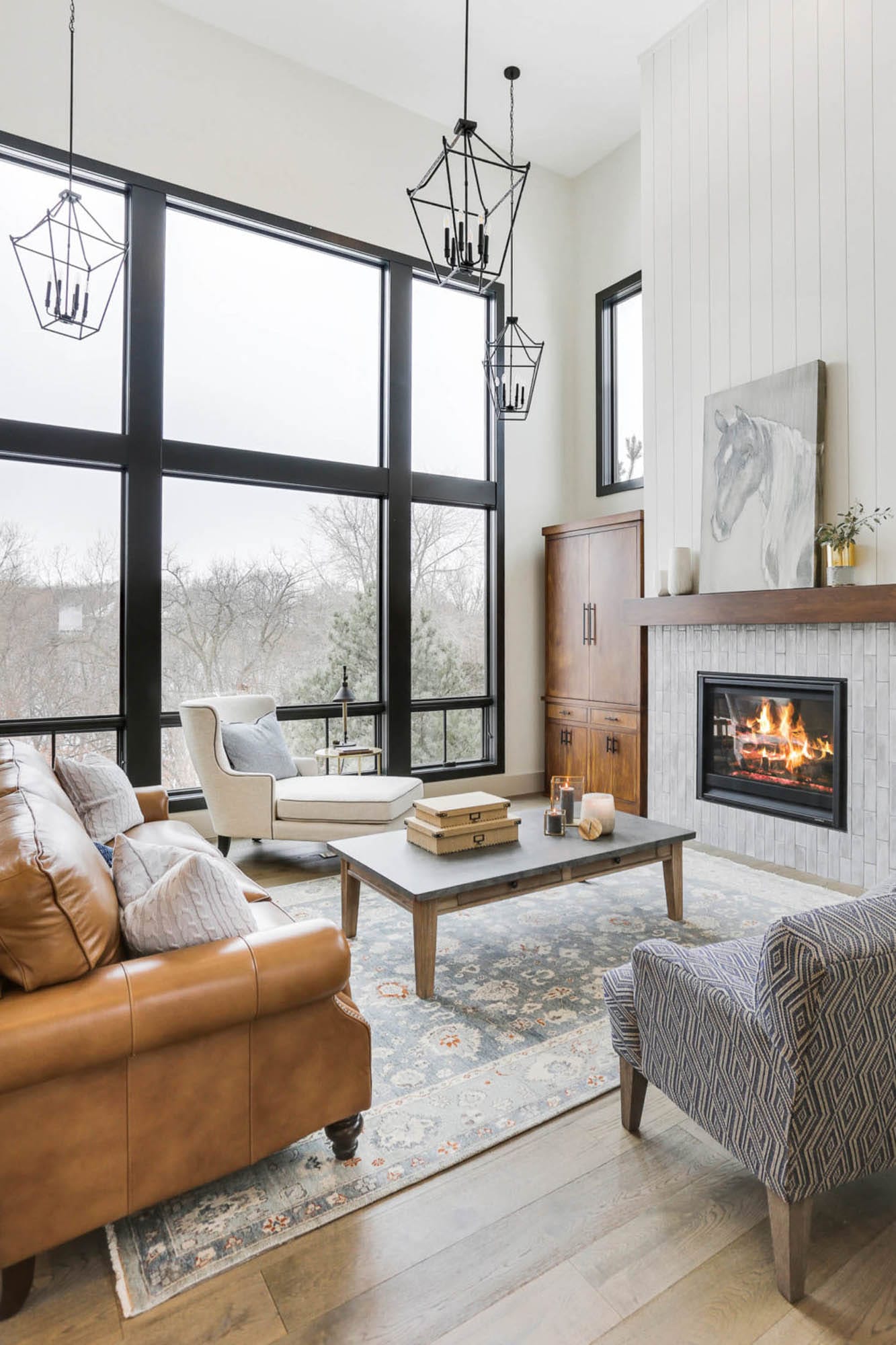

1. Small-Scale Patterns
A tile with a small pattern or a small-scale mosaic is ideal for making a small fireplace into a focal point. Don’t forget to consider the material and finish. Matte tile is casual and soft, glossy tile reflects the light and glass tile glamorizes a space with even more sparkle.
The crisp, white fireplace tile combined with the white walls and molding are a simple and clean backdrop for fun decor pieces to take center stage.

This fireplace stands apart stylishly with white marble subway tile that creates striking contrast against the dark navy walls.

This rustic fireplace serves double duty, not only separating the kitchen from the living space but also serving as a decorative focus in both rooms.

2. Cement & Cement-Look
Whether contemporary, old world, geometric or romantic, cement and cement-look tiles certainly liven up a fireplace. Pick a pattern you love, and enjoy an eye-catching and unique centerpiece.
This transitional fireplace is a delightful combination of traditional cement-look tile and a clean, contemporary mantle that satisfies all tastes.

A lively cement-look tile from the London series sets the modern farmhouse scene in this quaint home.

3. Floor to Ceiling
Impact is the ultimate goal with a floor-to-ceiling tiled fireplace. These jaw-dropping installations speak volumes.
This stunning fireplace is perfect parts rustic, contemporary and chic.

One way to make your fireplace unforgettable is to situate it in an unexpected place. This one gets bonus points for being enjoyed from the tub and the bedroom on the other side of the wall.

File this fireplace under “statement maker.” A soft, neutral grey tile becomes a focal point when it’s installed to the second-floor ceiling of this grand room.

4. 3-D
Taking your fireplace tile to the next dimension delivers a tactile, textural quality. Use a dimensional geometric tile for the ultimate contemporary statement.
A metallic fireplace tile is always a good idea—just imagine how the dimension and texture of this multifired tile shine when the fire is lit.

Elegant and refined, these soft flowing lines create dimension replicating that of calming coastal waves.

5. Trim Firebox
For a smoother transition between your fireplace surround and firebox, use trims and layering pieces to dress up the design and soften the hard edges.
A Somerset trim tile artfully frames this firebox while adding architectural detail.

The addition of trim to this stunning fireplace instantly elevates the whole look.

6. Architectural
Textured, dimensional architectural tiles are not just for rustic designs! For spaces from traditional to contemporary, these natural stones retain a neutral color scheme while adding touchable dimension.
It’s easy to see why our best-selling architectural tile, Claros Silver, is such a hit—classic grey shades and warm tans are universally appealing.

This centerpiece fireplace displays one of the perks of our architectural tile collections. We carry out corner pieces so your design can truly be three dimensional.

Excited to try something new? Visit our fireplace tile ideas page or our fireplace tile Pinterest board for more inspiration or find a store to get started today!
The post Our Favorite Fireplace Design Ideas appeared first on The Tile Shop Blog.
]]>The post Subway Tile Design Ideas & Tips appeared first on The Tile Shop Blog.
]]>history of subway tile

Created more than a century ago by architects Heins and LaFarge, the original subway tiles were used for, you guessed it, a subway—specifically the New York City subway in 1904. These tiles were perfect for subways because they were simple, clean and economical. They were so efficient that other major cities adapted subway tiles, from London’s Underground to Paris’ Metro. Soon, subway tiles became popular above ground as well, adorning Victorian kitchens and bathrooms because of their sanitary qualities.
Today, subway tiles are much more of a style statement, but that doesn’t mean they aren’t still functional and durable. Many people love them for this exact combination. However, there are more choices than ever to consider so knowing what is right for you can be tricky. That brings us to our top three things to consider when you pick out your tile.
Top 3 Things to Consider



Subway Tile Design Tips
Once you know what you want as far as size, finish and shape, it’s time to explore different subway tile designs and what makes them work.
Try using a patterned, wallpaper-look tile above a wainscot and subway tile in a complementary color on the bottom. This will add color and interest to a powder room, and you can still keep the palette neutral.

The vertical straight set pattern in the charming space below adds height to the small shower in a contemporary way. We love how this pattern continues right through the nook and brings mid-century modern style to this soothing room.

With subway tile, pattern is everything. In the frame below, a herringbone pattern defines a focal point without straying from a soft, neutral color palette. There are so many interesting details here to attract the eye.

Subway tile is wonderful as a blank canvas to support other points of interest. A dazzling waterjet mosaic (first photo) or an artistic piece of Laura Ashley art glass (second photo) stand out on a subway tile background. Grout in a complementary color helps the true centerpiece shine. To transition between your subway tile and focal point (and to show it off!), incorporate layering pieces that do double duty.


The character of brick and the versatility of subway tile come together in this beautiful space. An elongated tile in a herringbone pattern gives this cozy nook a unique, textured design.

One of the best things about subway tile is the variety of patterns possible. Here, a mix of vertical and horizontal straight stack on the wall lend a modern appearance and a bold, colorful pattern on the floor is a jolt of energy.

Ask Kirsty

You asked, she answered! Kirsty offers her advice on some of your most common subway tile questions.
How do I decide on a gloss or matte finish for my subway tile? Is gloss more timeless? What’s easier to keep clean?
Glossy finishes typically present a more traditional and elegant look. Their reflective quality can also make your space appear brighter. Matte finishes offer a more casual, relaxed appearance. They don’t reflect as much light and will give the space a softer look. As far as cleaning, both matte and glossy tiles have their benefits. Matte tile does not show smudges or splashes as easily as a glossy tile, but glossy tile is very easy to wipe down and clean.
What color grout should I use with white subway tile?
Grout has an incredible impact on your tile and the space around it. You have three options: matching, complementary or contrasting grout. The best option for you depends on your goals for the final look. Matching grout to the tile color gives a classic, clean, monochromatic and seamless appearance. A neutral and complementary grout color adds subtle contrast without being a focal point. Opt for a color that accents the tile and overall design. Contrasting your grout color to your tile adds character, creates a bold, dramatic look and shows off the tile pattern. The grout becomes a part of the design rather than the backdrop.

How do I match subway tile with my cabinets?
There is no one formula for matching tile and cabinetry. It’s about what appeals to you. One tip I recommend is to look at your closet. What color clothing do you have? To which colors do you tend to gravitate? Just like your clothing style, you want your home to reflect you and your individuality. It’s also important to think about contrasts. Do you want a monochromatic look or do you want your tile and cabinets to contrast one another? Deciding this will also help guide your tile choice.
What subway tile pattern should I use?
(Tip: Refer to our blog post on subway tile patterns and layouts for examples of these looks!)
The most popular layout is a traditional horizontal brick. To make that appear more modern, use a larger size tile. Vertical and horizontal straight stacks are more contemporary layouts. Any vertical pattern will add height to your space—an offset brick pattern is more traditional and a straight stack is more contemporary. More unique layouts, like crosshatch and herringbone, add dynamic patterns, whether in a monochromatic or multicolored palette. The beauty and glamour of a herringbone pattern are unbeatable.
Between all the shapes, sizes, finishes and patterns available for subway tile, there are countless designs to be discovered. However you decide to use subway tile, just make sure to follow The Tile Shop golden rule, and make it your own!
The post Subway Tile Design Ideas & Tips appeared first on The Tile Shop Blog.
]]>The post Style Guide: Cement & Cement-Look Tile appeared first on The Tile Shop Blog.
]]>
What is Cement Tile?
- Cement tiles are, of course, made of cement. Cement is similar to stone in that it has to be sealed, and it is very
long lasting . Cement tiles are thicker than average and made by hand. - Cement-look tiles are made of ceramic or porcelain. These are a great
lower cost option to achieve an authentic look that is still very durable.
Now that we cleared that up, let’s talk about how cement tiles are made.
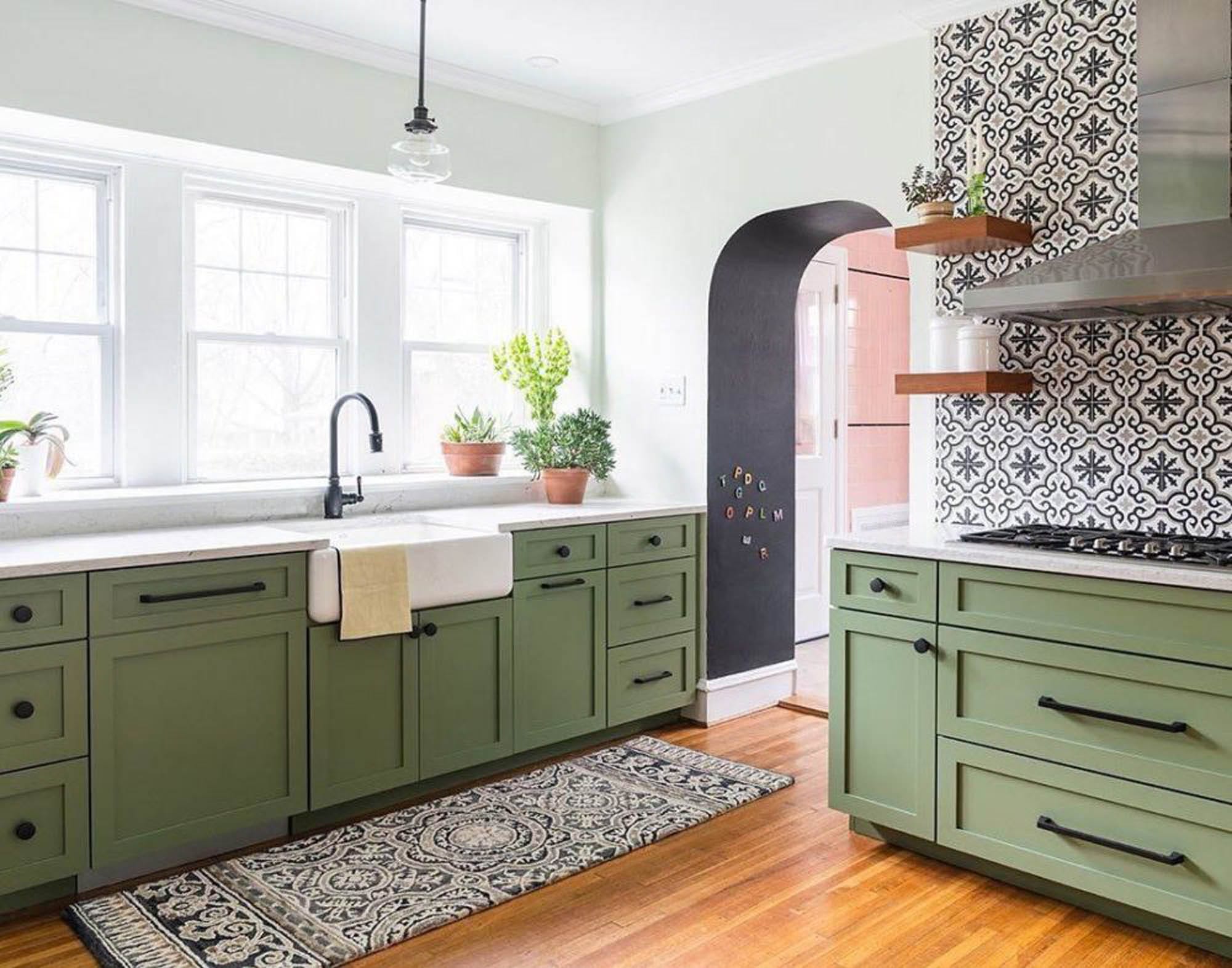
How Are Cement Tiles Made?
Cement tiles are made from a combination of marble dust, pigment and cement. Similar to natural stone, each tile is made by hand and takes between three and five minutes to make. What sets cement apart from other types of tile is that the pigment is pressed into the surface in a patterned mold instead of just being a thin layer on top. This means the coloration penetrates the surface of the tile, so if it wears down over time, the color will still remain and the pattern will not be impacted. The video below is a great overview of this process.
Care and Installation Tips
Inspired to design a work of art with cement tile? There are a few quirks specific to cement tile installation that
- Thickness: Cement tiles are thicker than average, so plan ahead! A threshold piece can be used to smoothly transition between cement tile and another flooring surface.
- Soaking: Cement tiles are absorbent and should be soaked in water before they are installed. This keeps the tiles from pulling moisture out of the mortar which would prevent it from curing properly.
- Sealing: It’s important to seal your clean and dry cement tiles after they’re installed to ensure they last.
- More information on installing cement tiles can be found here.
Historically Inspired Designs
Today, cement tiles take many forms and come in various materials. Due to their long and rich history, many designs seen today are based on those from the past. Explore some of our favorite historically inspired designs below.
The fresh, crisp colors below liven up this white kitchen.

The hand-painted look of the tile below adds to its authentic, old-world appeal.

Not ready to jump into all-over pattern? A backsplash highlighted with a frame is the perfect accent.

Modern farmhouse style is a popular look that benefits from the rustic appearance of cement tile.
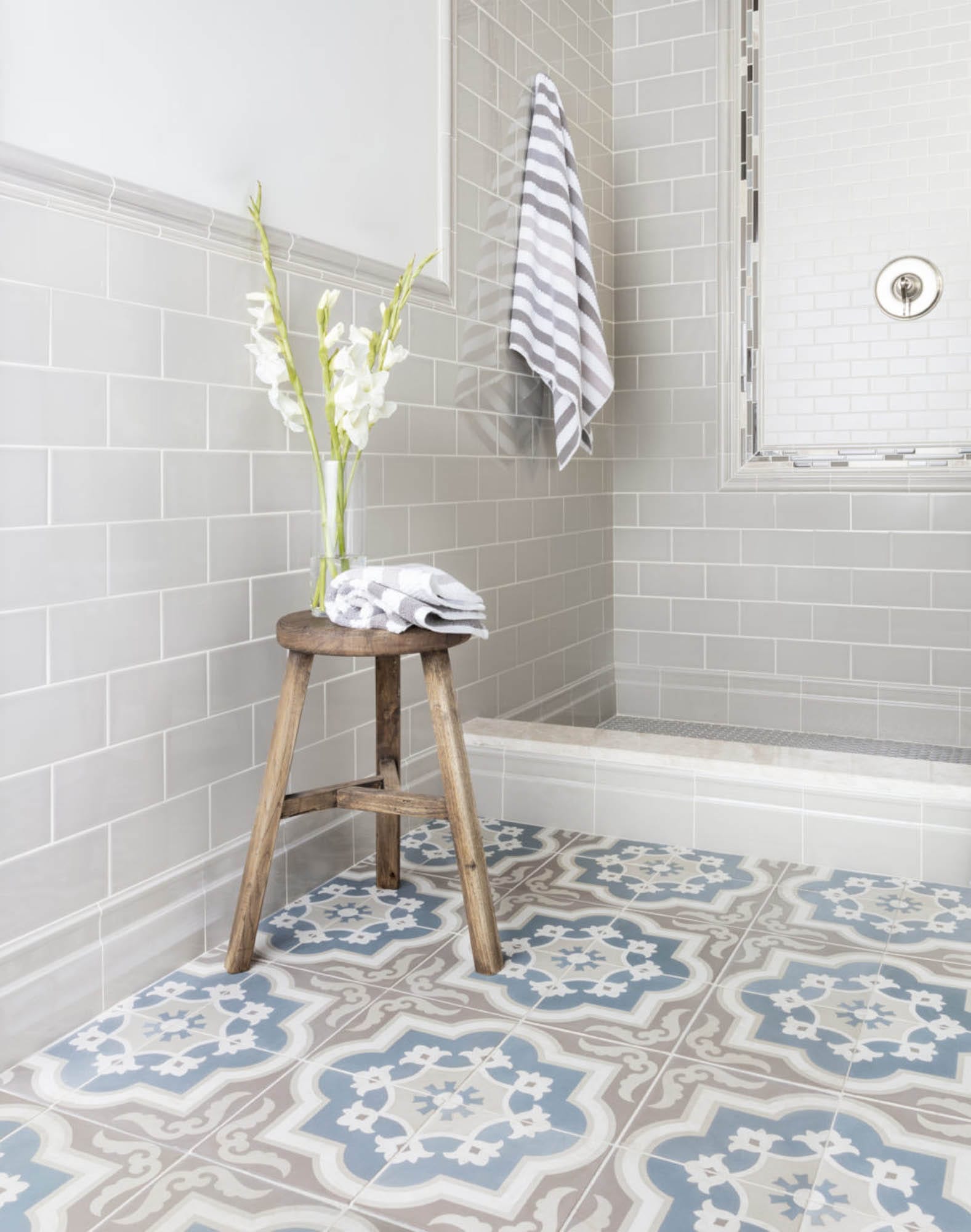
We love a fun shower space! This accent wall from floor to ceiling livens up this spacious shower.
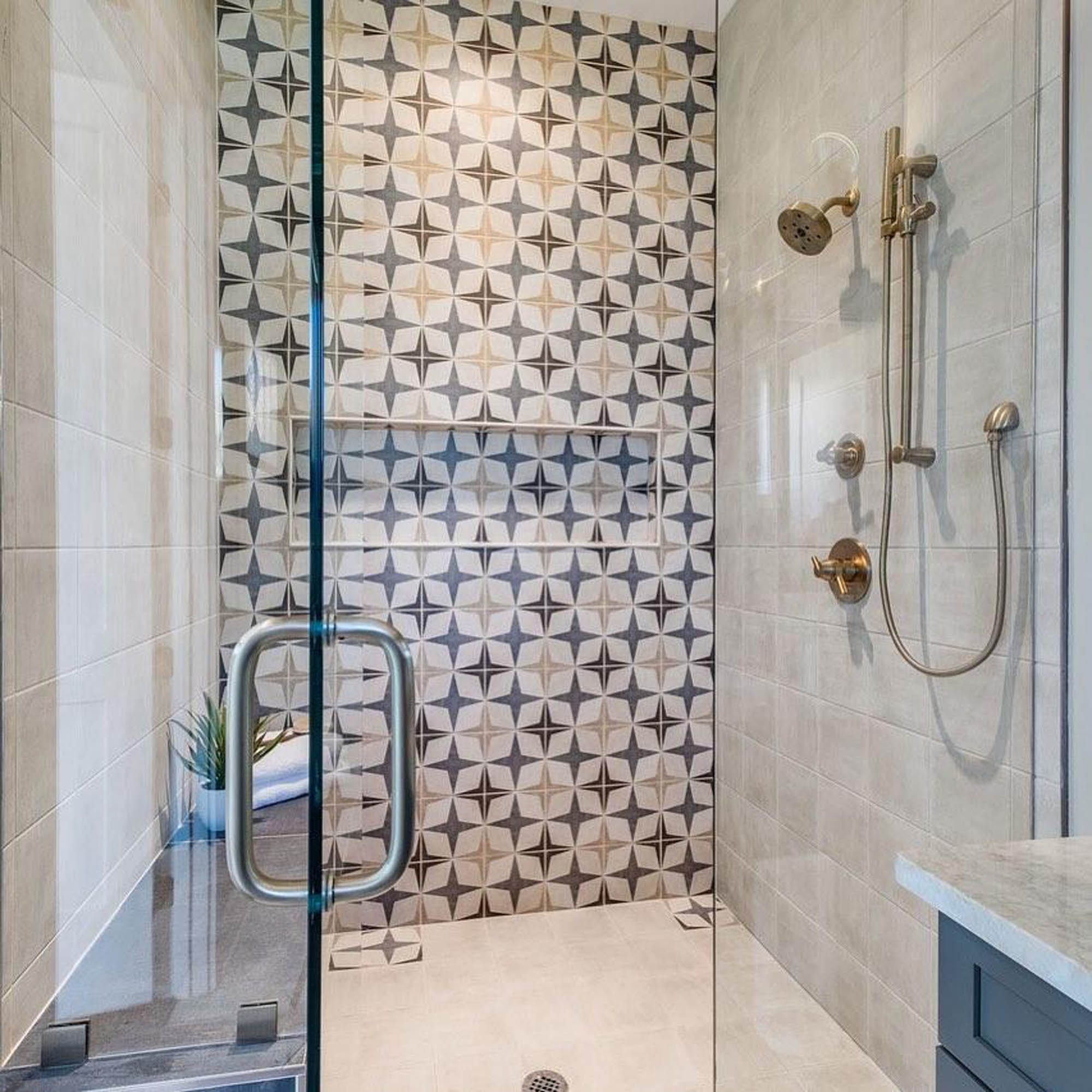
This tile design feels like it’s right out of an old European church. We love how Timber Trails Homes picked a shade of blue from the tile to paint the cabinetry, coordinating this mudroom from top to bottom. Sturdy porcelain is perfect for protecting the floor from laundry spills and tracked-in messes.

Think beyond the backsplash and shower. Cement tile takes this fireplace to another level and functions as a stunning focal point in this living room.
“A tiled fireplace is the perfect place to get a lot of bang for your buck in terms of style. A little pattern goes a long way!”—Kirsty Froelich, Tile Shop design manager

Star is one of our most popular tiles and for good reason! It’s versatile enough to pair with rustic wood-look tiles as well as contemporary hexagons while maintaining vintage appeal.


Contemporary Designs
As manufacturing processes evolve, so do designs. Now, the selection of cement and cement-look tiles is even broader than ever and encompasses many contemporary designs. If bold colors and geometric designs are more your style, explore some of our picks below.
This tile is definitely not one you would have found in 18th century Europe, and that’s one of the things we love about it. This thoroughly contemporary tile incorporates a geometric design and bright, bold colors.

A soft, contemporary grey patterned floor tile is the perfect complement to this preppy and traditional space.

We’re fans of a bold look, and this one fits the bill. This dramatic cement tile with its green leaf pattern creates an unforgettable floor.

If you want to dip your toe into cement without using an all-over pattern, mixing solid-color cement tiles with patterned tiles is a great way to get the best of both worlds.
“A checkerboard, random design or tiled rug are all attractive mix-and-match options for solid and patterned tiles.”—Kirsty Froelich, Tile Shop design manager
There’s something serene and calming about the ocean-blue hues of Blu Widow Hex.

Black-and-white tile is a design staple. Make it uniquely yours with this statement-making diamond pattern.

Combination
Do all cement-style tiles neatly fit into one of these two categories? Of course not! Some of the most interesting designs are a blend of old-world and contemporary styles, patterns and colors. Here are some of our favorites.
A black, white and grey color scheme updates a traditional design, blurring the lines between old world and contemporary.

A traditional design in unexpected colors lends a beautiful floral look to this bathroom.

There’s no shortage of interest in this arabesque tile. Soft traditional shapes combine with bold lines and hues to keep design lovers on their toes.

A historically inspired design plus on-trend wood look equal a stunning transitional style.
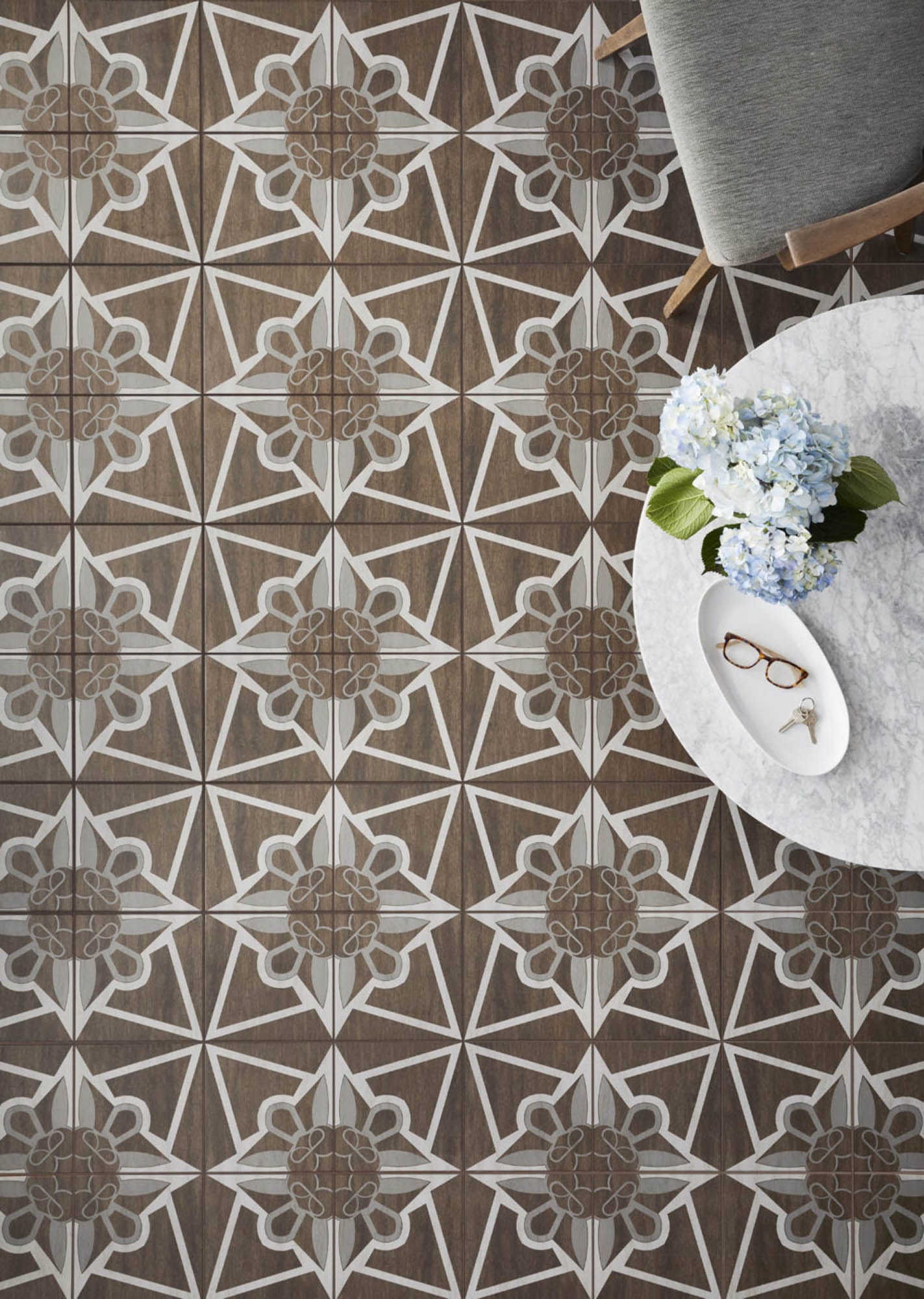
Explore more of our cement/cement-look and patterned tile now!
Ready to get started? Let our selection wow you in person—visit your local store today!
The post Style Guide: Cement & Cement-Look Tile appeared first on The Tile Shop Blog.
]]>
